Here we are providing Class 12 Biology Important Extra Questions and Answers Chapter 3 Human Reproduction. Important Questions for Class 12 Biology are the best resource for students which helps in Class 12 board exams.
Class 12 Biology Chapter 3 Important Extra Questions Human Reproduction
Human Reproduction Important Extra Questions Very Short Answer Type
Question 1.
Given below are the events in human reproduction. Write them in correct sequential order? Insemination, gametogenesis, fertilization, parturition, gestation, implantation.
Answer:
Gametogenesis, insemination, fertilization, implantation, gestation, parturition.
Question 2.
The path of sperm transport is given below. Provide the missing steps in blank boxes:

Answer:
A = Vasa efferentia; B = Vas deferens.
Question 3.
What is the role of the cervix in the human female reproductive system?
Answer:
The cavity of the cervix called the cervical canal, and the vagina collectively forms the birth canal for parturition. It also regulates the entry of sperms into the uterus.
Question 4.
Why are menstrual cycles absent during pregnancy?
Answer:
The high levels of progesterone and estrogens during pregnancy suppress the gonadotropins which are essential for the transformation of the primary follicle into Graafian follicle and ovulation.
Question 5.
Give the scientific term for the following:
1. Release of the ovum from the ovary.
2. Onset of the menstrual cycle in females.
3. The structures that pick up ova from the body cavity.
Answer:
- Ovulation
- Menarche
- Fimbriae.
Question 6.
What is the location of Cowper’s glands in the body?
Answer:
Cowper’s glands are situated laterally attached to the urethra beneath the urinary bladder at the base of spongy tissue.
Question 7.
Where are sperms stored in males?
Answer:
They are stored in the epididymis.
Question 8.
What is follicular atresia?
Answer:
Follicles in the ovaries which undergo regression and disappear due to death and disposal by phagocytes during the reproductive years of the female are referred to as follicular atresia.
Question 9.
Which particular part of mammalian sperm secretes enzymes to facilitate penetration of sperm?
Answer:
Acrosome.
Question 10.
Name the hormones involved in the regulation of spermatogenesis.
Answer:
GnRH, LH, FSH, Androgen Binding Protein (ABP), Inhibin, androgens.
Question 11.
How many eggs do you think were released by the ovary of a female dog which gave birth to six puppies? HOTS
Answer:
Six eggs.
Question 12.
What will happen if the fallopian tubes are partially blocked and the ovulated eggs are prevented from reaching the uterus?
Answer:
Fertilization may take place but the zygote may develop in the tube instead of the uterus.
Question 13.
Name the cells which produce testosterone. What is the function of this hormone?
Answer:
Interstitial cells (Leydig’s cells) of testis secrete the testosterone hormone. Function. They control secondary sexual characters.
Question 14.
How does the ovum which is released in the body cavity enter the fallopian tube?
Answer:
Ciliary movements of epithelial cells lining the lumen of nearby fallopian tubes induce the ovum to pass into the open fimbriated funnel-shaped end called ostium.
Question 15.
At what stage of life is oogenesis initiated in a human female? When does the oocyte complete oogenesis? (CBSE Sample Paper)
Answer:
Oogenesis is initiated during the embryonic development stage. It is completed at the time of ovulation.
Question 16.
When do morphogenetic cell movements take place?
Answer:
As blastocyst undergoes gastrulation.
Question 17.
Define spermiogenesis. Where does it occur? (CBSE Delhi 2008 (S))
Answer:
The transformation of non-motile spermatids into motile spermatozoa is called spermiogenesis. It occurs inside seminiferous tubules of testes.
Question 18.
How does colostrum provide initial protection against diseases to newborn infants? Give one reason. (CBSE 2009)
Answer:
The colostrum provides antibodies that are essential to developing resistance for newborn babies.
Human Reproduction Important Extra Questions Short Answer Type
Question 1.
Why scrotal sacs are present outside the body? (CBSE Outside Delhi 2014)
Answer:
The scrotal sac is a pouch of deeply pigmented skin divided into two separate sacs. Each sac contains one testis. The normal temperature of the testes in the scrotum is about 2°C lower than the internal body temperature, the ideal temperature for developing sperms.
Question 2.
Write the location and functions of Sertoli cells in humans? (CBSE 2012, 2014)
Answer:
Sertoli cells. These are present in the seminiferous tubules of the testis. They provide nutrition to germ cells. They play a vital role in the maturation of spermatids into motile sperms.
Question 3.
Name the muscular and glandular layer of the human uterus. Which one of these layers undergoes cyclic changes during the menstrual cycle? Name the hormone essential for the maintenance of this layer. (CBSE 2009)
Answer:
- Muscular layer – Myometrium
Glandular layer – Endometrium. - Endometrium undergoes cyclic changes during the menstrual cycle.
- LH hormone maintains the lining of the uterus.
Question 4.
Study the figure given below and answer the questions that follow:
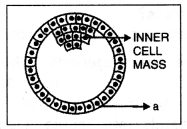
(i) Name the stage of the human embryo the figure represents.
Answer:
Blastocyst (Blastula).
(ii) Identify ‘a’ in the figure and mention its function.
Answer:
Trophoblast
(iii) Mention the fate of the inner cell mass after implantation in the uterus,
Answer:
Inner cell mass gets differentiated as embryo after implantation.
(iv) Where are the stem cells located in this embryo? (CBSE 2009)
Answer:
Stem cells are located in the inner cell mass.
Question 5.
Write two major functions each of testis and ovary?
Answer:
Functions of Testis:
- Production of sperms and
- Secretion of male sex hormones, androgens (e.g. testosterone).
Functions of Ovary:
- Production of ova and
- Secretion of female sex hormones, e.g. estrogens, progesterone.
Question 6.
What is the function of the acrosome and head?
Answer:
Functions of acrosome: It secretes sperm lysins which dissolve the membrane around the egg and thus facilitate the penetration of sperm into the ovum.
The function of the head: Head contains a nucleus that contains hereditary information. The fusion of nuclei is involved during fertilization.
Question 7.
Point out the differences in male and female urethra?
Answer:
In the case of the male urethra, there is a single opening for the elimination of urine and for the ejaculation of sperms. In females, there are two separate openings, one for the elimination of urine and the other is a vaginal orifice. The urethra in males is continued into the penis and in the case of females, it has not been found.
Question 8.
Draw a labeled diagram of a part of the seminiferous tubule showing spermatogenesis. (CBSE Delhi 2010, 2014, Outside Delhi 2019)
Answer:
Section of the testis:
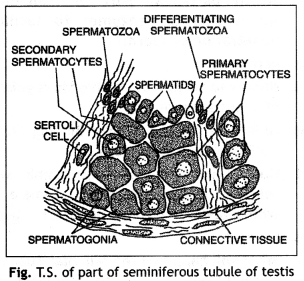
Question 9.
During reproduction, the chromosome number (2n) reduces to half (n) in the gametes and again the original number (2n) is restored in the offspring. What are the processes through which these events take place?
Answer:
- Chromosome number is reduced to half or (n) during gametogenesis.
- Restoration of chromosome number to diploid or (2n) stage occurs during fertilization.
Question 10.
What is the significance of ampullary- isthmic junction in the female reproductive tract?
Answer:
The ampullary isthmic junction is the site where fertilization of the ovum takes place.
Question 11.
Draw a labeled diagram of the section through the ovary.
Or
Draw a labeled diagram of a section through the ovary showing various stages of follicles growing in it. (CBSE Delhi 2014, 2019)
Answer:
T.S. of Ovary:
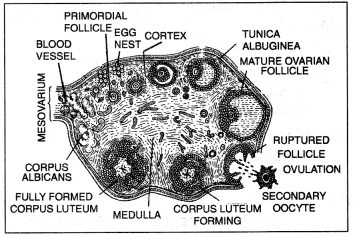
Fig. T.S. of Ovary
Question 12.
Differentiate between Graafian follicle and Corpus luteum.
Answer:
| Graafian follicle | Corpus luteum |
| 1. SphericaL or at the sac-Like mass of cells. | 1. Large mass of big conicaL yellow cells. |
| 2. Each Graaflan follicle contains a Large, centrally placed ovum surrounded by many Layers of granuLar cells. | 2. It is the structure formed after the release of the ovum. |
| 3. Estrogen hormone is secreted. | 3. Progesterone hormone is secreted. |
Question 13.
Differentiate between spermiogenesis and speciation. (CBSE Outside Delhi 2019)
Answer:
Difference between spermiogenesis and Speramiation: Spermiogenesis is the process of transformation of non-motile spermatids into mature motile sperms (male-gametes) whereas speciation is the release of sperms from Sertoli cells of seminiferous tubules.
Question 14.
Define ooplasm and germinal vesicle.
Answer:
- Ooplasm: The cytoplasm of the haploid ovum is called the ooplasm.
- Germinal vesicle: The nucleus of the ovum at the time of fertilization is termed a germinal vesicle.
Question 15.
Explain the significance of fertilization.
Answer:
Significance of fertilization.
- The fusion of male and female pronuclei in fertilization restores the diploid number of chromosomes.
- The activation of secondary oocyte undergoes maturation to form ovum.
- Fertilization initiates cleavage or segmentation.
- The combination of the chromatin material from two different parents forms the physical basis of biparental inheritance and variation.
Question 16.
What is the cortical reaction?
Answer:
It is a reaction occurred during fertilization that presents polyspermy, i.e. fusion of multiple sperm with one egg. In this reaction, the cortical granules present beneath the secondary oocyte’s plasma membrane fuse with the plasma membrane and release their contents (enzymes) between the plasma membrane and zona pellucida. These enzymes harden the zona pellucida.
Question 17.
What is a fetus?
Answer:
It is the unborn young one of a viviparous animal after it has taken form in the uterus. In human beings, it represents the product of conception from the end of the eighth week to the moment of birth.
Question 18.
List the characteristics of the morula stage.
Answer:
Characteristics of morula stage:
- The embryo consists of a solid ball of cells called blastomeres. They are arranged like a mulberry.
- Morula consists of an outer layer of smaller cells and an inner mass of larger cells.
- Zona pellucida layer persists during morula.
Question 19.
What is the placenta?
Answer:
It is the structure formed by the union of the fetal and uterine tissue for purpose of nutrition, respiration, and excretion of the embryo. Although the blood vessels of the embryo and the mother come close but are kept separated by some barriers between them. The useful substances pass from maternal blood to fetal blood while the wastes (excretory products and C02) are passed from the fetal blood to maternal blood.
Question 20.
Give the names and functions of the hormones involved in the process of spermatogenesis. Write the names of the endocrine glands from where they are released.
Answer:
| Hormone | EndocrIne gland | Functions |
| (1) FSH | Antenor pituitary | StimuLates Sertoli cells to secrete some factors which help in spermatogenesis. |
| (2) ICSH/LH | -do- | StimuLates Leydig’s cells of testes to secrete androgens (especially testosterone) which regulate spermatogenesis. |
Question 21.
How does colostrum provide initial protection against diseases to newborn infants? Give one reason. (CBSE 2009)
Answer:
The colostrum provides antibodies that are essential to developing resistance for newborn babies.
Question 22.
Diagrammatically shows the development of the human embryo in the female reproductive tract.
Answer:
Events of development:
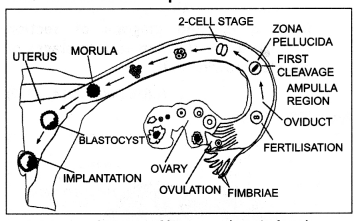
Fig. Development of the human embryo in the female reproductive tract (Fertilisation-implantation)
Question 23.
When and where do chorionic villi appear in humans? State their function. (CBSE Delhi 2013, 2019)
Answer:
- After implantation, finger-like projections appear on the trophoblast called chorionic villi. They are surrounded by uterine tissue and maternal blood.
- The chorionic villi and uterine tissue become interdigitated with each other and jointly form structural and functional units between the developing embryos and maternal bodies called the placenta.
Question 24.
State the fate of the trophoblast of a human blastocyst at the time of implantation and that of the inner cell mass immediately after implantation. (CBSE Outside Delhi 2019)
Answer:
The trophoblast layer of the human blastocyst gets attached to the endometrium and the inner cell mass gets differentiated into an embryo. After attachment, the uterine cells divide rapidly and cover the blastocyst. As a result, the blastocyst becomes embedded in the endometrium of the uterus. It is termed Implantation.
Human Reproduction Important Extra Questions Long Answer Type
Question 1.
Briefly explain the primary male sex organs of man.
Answer:
The testes, male gonads, produce sperms that are suspended outside the abdominal cavity in a sac of skin called the scrotum. It results in maintenance of the temperature of the testis which is lower than the rest of the body. It is a condition favorable to sperm production.
Each testis is an oval-shaped structure and is composed of a large number of seminiferous tubules surrounded by connective tissue in which occurs numerous cells called Interstitial cells or Leydig cells. These cells produce a male sex hormone named testosterone. Seminiferous tubules are lined by a layer of germinal epithelial cells. In between the germinal cells, certain large cells called Sertoli cells are present. They are nutritive in function. The germinal epithelial cells produce sperms by spermatogenesis.
Question 2.
Draw well-labeled sketches of the front view and sagittal section of the male reproductive system of man. (CBSE Delhi 2019)
Answer:
The male reproductive system of man:
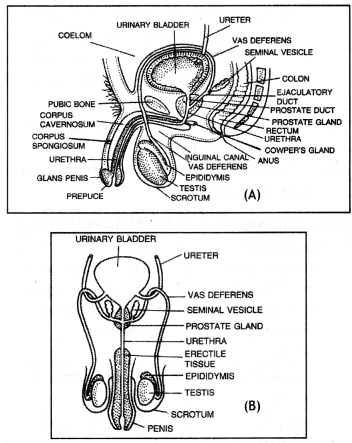
Question 3.
Explain the events taking place at the time of fertilization of an ovum in a human female. (CBSE 2010, 2014, (Delhi) 2016)
Answer:
Fertilization is the fusion of two gametic nuclei to form a diploid zygote. It involves a series of chemical and physical steps as follows:
The cortical cytoplasm of the ovum shows the physicochemical reactions called the cortical reactions:
- Sperm lysins dissolve the membranes around the egg.
- The Head of sperm containing a nucleus and proximal centriole physically passes into the ovum.
- Normally these reactions result in the formation of a fertilization membrane outside the egg plasma membrane.
- Cortical granules burst and release their contents between the egg plasma membrane and zona pellucida, i.e. perivitelline space (no fertilization membrane formation). The plasma membrane shows increased permeability for water, phosphate, and potassium.
- The electrical potentiality of plasma membrane changes from positive to negative, NAD kinase enzyme becomes activated after fertilization for the oxidation and reduction reaction of the cell.
- The rate of DNA synthesis increases with great pace after fertilization. Hence the ovum is now ready for mitosis (cleavage).
- Cleavage results in multicellular individuals.
Question 4.
Give the hormonal control of the male reproductive system. (CBSE Delhi 2009)
Answer:
Hormonal control of the male reproductive system:
1. Hypothalamus: It releases gonadotropin-releasing hormones (GnRH) which bring the release of gonadotropins from the pituitary.
2. Anterior pituitary secretes two gonadotropins:
(a) Follicle Stimulating Hormone (FSH): It stimulates spermato¬genesis in the germ cells of seminiferous tubules of the testis to produce haploid and motile male gametes, called spermatozoa, so is also called games kinetic hormone.
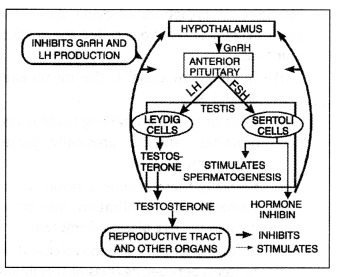
Fig. Hormonal control of the male reproductive system
(b) Interstitial Cells Stimulating Hormone (ICSH): It stimulates interstitial cells to secrete male sex hormone called testosterone.
3. Sertoli cells secrete androgen binding protein (ABP) which concentrates testosterone in the seminiferous tubules.
4. Testosterone hormone secreted by interstitial or Leydig’s cells of testes. It regulates secondary sex organs and secondary sexual characters. It regulates the growth, maintenance, and functioning of secondary sex organs like epididymis, vasa deferentia, prostate gland, seminal vesicles, penis, etc. Testosterone also stimulates the development of mate secondary sexual characters like the appearance of facial hair, deepening of the voice, broadening of shoulders, elongation of bones, and increase in height.
Question 5.
Give an account of the secondary sex organs of a human male. (CBSE Delhi 2011)
Answer:
Secondary Sex OrgAnswer: The tubules meet and join at one end of the seminiferous to form ducts called rete testes that form vasa efferentia leading to the epididymis. It is a narrow tube about 6 m long lying in a coiled mass on the outside of the testis and store sperms. The epididymis in turn leads to the muscular sperm duct, the two sperm ducts open into the top of the urethra, just below the point where it leaves the bladder.
In a short coiled tube, the seminal vesicle branches from each sperm duct just above its opening into the urethra. Reproductive glands. They open into the urethra, the prostate gland, which surrounds it at the point where it leaves the bladder and Cowper’s gland a little lower down.
The urethra in males traverses through the corpus Spongiosum of the penis. Corpora Spongiosum consists of spongy and highly vascular connective tissue containing numerous small spaces that are normally empty but filled with blood when the penis is erect during copulation. The penis becomes erect and firm to facilitate the ejaculation of semen (spermatic fluid) into the vagina of the female.
Question 6.
Differentiate between vasa deferentia and vasa efferentia.
Answer:
Differences between vasa deferentia and vasa efferentia:
| Vas deferens | Vasa efferentia |
| 1. Vas deferens is the main duct that carries the sperms from the epididymis to the urethra. | 1. They are 10-20 smaLL tubuLes which transfer sperms from rete testes to the epididymis. |
| 2. It conveys mature sperms. | 2. It conveys immature sperms. |
| 3. Accessory reproductive glands pour their secretions into it. | 3. No secretions are added to it. |
Question 7.
Describe the structure of the seminiferous tubule.
Answer:
Each seminiferous tubule is lined by germinal epithelium. The majority of cells in this epithelium are cuboidal spermatogenic cells but a few are large, pyramidal, supporting Sertoli or nurse cells. The cuboidal cells, by mitotic divisions, produce spermatogonia into the lumen of the seminiferous tubule.
The spermatogonia grow into primary spermatocytes, which undergo meiosis, producing haploid cells, first secondary spermatocytes, and then spermatids. The latter metamorphose into spermatozoa. Differentiation of spermatozoa from spermatogonia is called spermatogenesis. The spermatozoa are nourished during development by nurse cells. Mature spermatozoa lie free in the cavity of the seminiferous tubules. Scattered in the connective tissue are Leydig’s cells which secrete a hormone called testosterone.
Question 8.
The mother germ cells are transformed into a mature follicle through series of steps. Provide the missing steps in the blank boxes.

Answer:
A = Primary oocyte; B = Secondary follicle, C = Tertiary follicle.
Question 9.
What is the difference between a primary oocyte and a secondary oocyte?
Answer:
| primary oocyte | secondary oocyte |
| 1. It is a diploid structure. | 1. It is a haploid structure. |
| 2. It is formed from oogonium through mitosis and differentiation. | 2. It is formed from the primary oocyte after it undergoes the first meiotic division. |
| 3. No polar body is formed during its development. | 3. A polar body is extruded during its formation. |
Question 10.
What is spermiogenesis? List the changes that take place during spermiogenesis.
Answer:
Spermiogenesis. The process of differentiation of motile sperm from the spermatid is called spermiogenesis.
Changes during spermiogenesis:
- The nucleus becomes compact and forms the head.
- Distal centriole forms the tail of the sperm.
- The acrosome is formed at the tip of the head.
- Mitochondria get arranged in the form of a spiral.
- The cytoplasm is changed to a sheath.
Question 11.
Draw a mammalian sperm and label its four major parts. (CBSE Delhi 2008, 2011, 2013)
Answer:
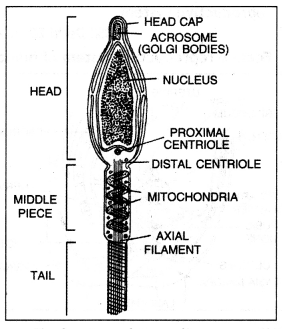
Question 12.
Give the functions of the following:
1. corpus luteum
2. endometrium
3. acrosome
4. sperm tail
5. fimbriae.
Answer:
1. Functions of corpus luteum:
(a) It secretes a small amount of estradiol hormone and a significant amount of progesterone.
(b) It also secretes the relaxin hormone.
2. Functions of the endometrium:
(a) It is an internal layer of the uterus. It undergoes cyclic changes during the menstrual cycle.
(b) It provides pits for implantation of the blastocyst.
(c) It takes part in the formation of the placenta.
3. Function of acrosome: It contains hydrolytic enzymes that are used to contact and penetrate the egg at the time of fertilization.
4. Function of sperm tail: It provides motility to the sperm.
5. Function of fimbriae: They help in the collection of ovum after ovulation.
Question 13.
Draw a labeled diagram of the human female reproductive system. (CBSE Delhi 2011, 2013)
Answer:
The female reproductive system of human:
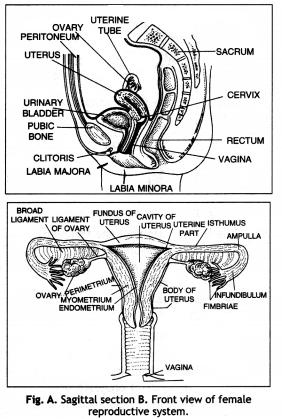
Question 14.
Write a short note on the structure and functions of the vagina.
Answer:
Structure of vagina: The vagina is a muscular tube lined with a membrane. It is composed of a special type of stratified epithelium which is supplied with blood vessels and nerves. It extends from the uterus to the vestibule. The anterior surface of the vagina is in relation to the base of the bladder and urethra. The vagina receives the male sex organ during copulation.
Functions of the vagina:
- It receives the penis of males during copulation.
- It serves as the receptacle for the sperms.
- It acts as a birth canal.
Question 15.
Draw a labeled diagram of the Graafian follicle and ovum. (CBSE 2011, 2012)
Answer:
Graafian follicle:
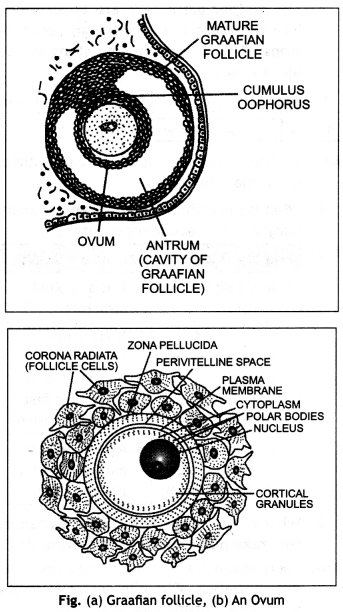
Question 16.
What is a menstrual cycle? Give an account of a simplified 28-day menstrual cycle. (CBSE 2019 C, Outside Delhi 2019)
Answer:
Menstrual cycle: The cycLic changes that occur in the reproductive organs of primate femaLes (monkeys, apes, and human beings) constitute the menstruaL cycLe. The cycLe of events starts from one menstruation tiLt the onset of the next and Lasts for about 28/29 days (a menses).
Simplified menstrual cycle (28-day Cycle):
| Phase | Days | Events |
| Menstrual phase | 1-5 | Endometrium breaks down, menstruation begins. The cells of en domain urn, secretions, blood, and the unfertilized ovum constitute the menstrual flow. |
| Follicular phase (ProLiferative phase) | 6-13 | Progesterone production is reduced. In fact, menstrual flow is associated with withdrawaL of progesterone. |
| Ovulatory phase | 14 | Endometrium rebuilds, FSH secretion, and estrogen secretion increase. |
| Luteal phase (Secretory phase) | 15-28 | Both LH and FSH attain a peak level. The concentration of estrogen in the blood is also high and reaches its peak. Ovulation occurs. Corpus luteum secretes progesterone. The endometrium thickens and uterine glands become secretory. |
Question 17.
Show with graphic sketch the hormonal control over the menstrual cycle.
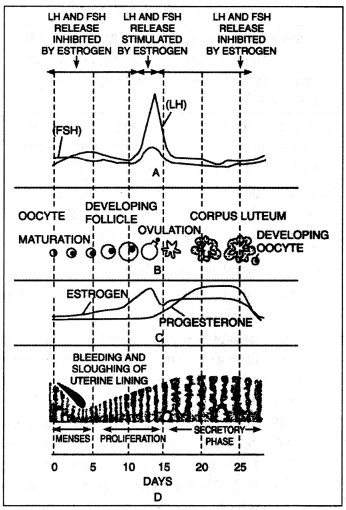
Fig. MenstruaL cycLe showing hormonal relations: (A) Gonadotropin, (B) Ovarian cycle, (C) Ovarian hormones, (D) Uterine cycle.
Question 18.
DifferentIate between proliferative and secretory phases.
Answer:
Differences between proliferative and secretory phases:
| Proliferative phases | Secretory phases |
| 1. Growth of Graafian follicle and maturation and release of ovum occurs. | 1. Prepares the uterus for receiving the fertilized ovum and in case, there is no fertilization, endometrium breaks resulting in bleeding. |
| 2. It is the first phase that follows menstruation. | 2. It is the second phase that folLows after the release of an ovum. |
| 3. It starts on the 5th day of menstruaL cycLe and Lasts up to 14 days. | 3. It starts after the 14th day when the corpus Luteum is formed. |
| 4. It is caused by estrogen and controLled by FSH. | 4. Corpus Luteum is formed under the impact of LH. |
| 5. Contraction of uterine muscLes increases. | 5. Contraction of uterine muscles decreases. |
Question 19.
1. What is ovulation?
2. What happens to the Graafian follicle after ovulation?
Answer:
1. Ovulation: The release of eggs (at secondary oocyte stage) after rupturing of Graafian follicle is called ovulation.
2. After the ovulation, the granulosa cells as well as the stroma cells from theca Interna rapidly multiply to fill the cavity of the Graafian follicle which becomes the corpus luteum. If fertilization occurs, the corpus luteum grows further and secretes hormone. If fertilization does not take place, the corpus luteum regresses and forms a yellow body.
Question 20.
Differentiate between zona pellucida and corona Radiata.
Answer:
Differences between zona pellucida and corona Radiata:
| Zona Pellucida | Corona Radiata |
| 1. The non-ceLLuLar, secretory layer around the ovum is termed zona Pellucidar (or Coleman). | 1. The ceLLular layer around zona petLucida is termed Corona Radiata. |
| 2. This Layer is thick and transparent. | 2. It is a very thick layer of follicular cells with granular cytoplasm. |
| 3. It encLoses perivitelline space around the pLasma membrane. | 3. It does not enclose any space. |
Question 21.
Compare mature mammalian sperm and ovum.
Answer:
Similarities:
- Both are gametes and take part in fertilization,
- Both are haploid.
- Both are a carrier of the heredity characters,
- Both are unicellular structures.
Differences:
| Mammalian sperm | Mammalian ovum |
| 1. Sperm is motiLe and encLosed by an only singLe plasma membrane. | 1. Ovum Is sphericaL, non-motile, and surrounded by zona pesticide and corona radiate. |
| 2. It is differentiated into four parts, i.e. head, neck, middle piece, and tait. | 2. It is a spherical, aLecithaL egg with acentric nucLeus. |
| 3. SmaLL amount of cytopLasm present. | 3. A large amount of cytoplasm. |
| 4. Centriotes and acrosome present. | 4. CentnoLe and acrosome absent. |
| 5. Mitochondria arranged in the form of a spiral. | 5. Mitochondria scattered in the cytoplasm. |
Question 22.
Briefly explain the steps of fertilization. (CBSE Delhi 2019)
Answer:
Fertilization is the process of fusion of motile sperm and non-motile ovum which takes place in the fallopian tube (oviduct).
- Fertilization is internal in human females.
- Fertilization is a Physico-chemical process.
- Acrosome in sperm’s head releases enzymes that dissolve the membrane of the egg to facilitate entry of sperm into the ovum.
Steps involved during fertilization:
- Acrosomal reactions and penetration of sperm.
- Cortical granule reaction.
- Formation of pronuclei.
- The fusion of pronuclei.
Question 23.
In our society, women are often blamed for giving birth to their daughters. Can you explain why this is not correct? (CBSE Delhi 2014)
Answer:
Sex chromosomes determine sex in human beings. In males, there are 44+XY chromosomes, whereas, in females, there are 44+XX chromosomes. Here X and Y chromosomes determine sex in human beings.
Two types of gametes are formed in males, one type is having 50% X-chromosome, whereas another type is having Y-chromosome. In females, gametes are of one type and contain X-chromosome. Thus females are homogametic. If a male gamete having Y-chromosome (endosperm) undergoes fusion with a female gamete having an X-chromosome, the zygote will have an XY chromosome and this gives rise to a male child.
If a male gamete having an X-chromosome (gymnosperm) undergoes fusion with a female gamete having an X-chromosome, the zygote will be having XX-chromosome and this gives rise to a female child.
Question 24.
What is fetal ejection reflex? Explain how it leads to parturition?
Answer:
Fetal ejection reflex is a neuroendocrine mechanism initiated by a fully formed fetus and placenta which helps in parturition.
It operates as below:
- Foetus secretes hormones from its adrenal glands. These hormones stimulate the posterior pituitary of the mother to release oxytocin.
- Oxytocin causes forceful contraction of smooth muscles of myometrium called labor pains, which further stimulates more secretion of oxytocin.
- The stimulatory reflex between uterine contraction and oxytocin secretion continues which causes more forceful contraction of uterine muscles.
- Uterine contraction pushes the young gradually out through the dilated cervix (caused by relaxin) and vagina.
Question 25.
Give an account of the histology of testis.
Answer:
Each testis is composed of a large number of seminiferous tubules surrounded by connective tissue in which there are numerous cells present called interstitial cells or Leydig cells. The testis is covered by a layer of dense connective tissue called tunica albuginea. From it, various septa radiate inward into the cavity of the testis dividing it into many lobules. The seminiferous tubules are coiled structures.
Each tubule is lined by a layer of germinal epithelial cells. In between the germinal cells, certain large cells called Sertoli cells are present. They are nutritive in function. The germinal epithelial cells give rise to sperms. They are in various stages of development like spermatogonia, primary spermatocytes, secondary spermatocytes, and spermatids. The Leydig cells which lie in connective tissue produce a male sex hormone called testosterone.
Question 26.
Explain the histological structure of the mammalian ovary.
Answer:
The ovary is a female gonad: It produces female sex cells called ova and the female sex hormones. Histologically the ovary is composed of fibrous connective tissue.
Its central part is called the stroma. It contains blood capillaries and nerve fibers. The outer part is called the cortex. A large number of Graafian follicles are embedded in a cortical layer. Each follicle is sac-shaped and contains female germ cells. It develops from the germinal layer. In a sexually mature female, the follicles are all at different stages of development and of different sizes. The cells of follicles are all of different sizes.
The cells of the follicle secrete a hormone called estrogen. In the connective tissue are present corpus luteum. It is formed at the site of a ruptured Graafian follicle. It secretes another hormone called progesterone.
Question 27.
What is spermatogenesis? Briefly describe the process of spermatogenesis.
Or
Give a schematic view of spermatogenesis in humans. (CBSE Delhi 2008, 2010)
Answer:
Spermatogenesis. The process of sperm formation from the sperm mother cells of testis (male gonad) is called spermatogenesis. It is completed in four phases, viz. spermatocytogenesis, meiosis I, meiosis II, and spermiogenesis. Spermatocytogenesis, Meiosis I and Meiosis II. The sperms are formed from the sperm mother cells present in the germinal layer of seminiferous tubules of the testis. Some of the mother cells enlarge to divide mitotically to form spermatogonia.
Growth phase: Some of them enter a period of growth and are called primary spermatocytes which are diploid.
Maturation phase: These cells divide meiotically to form two haploid secondary spermatocytes. Each secondary spermatocyte again divides mitotically. Thus one primary spermatocyte forms haploid spermatids.
Spermiogenesis: These develop into complete spermatozoan. These possess head which is embedded in the nourishing cells called Sertoli cells. The process of conversion of spermatid into spermatozoan is called spermiogenesis or spermine peliosis.
Since each primary spermatocyte divides meiotically to form 4 sperms thus 400 sperms or spermatozoa will be formed from 100 primary spermatocytes. The sperm consists of the acrosome (head), nucleus, and tail.
When sperm production starts, this age is called sexual maturity. It is generally 14-16 years. Spermatogenesis is controlled by the hormone (FSH) of the anterior lobe of the pituitary gland.
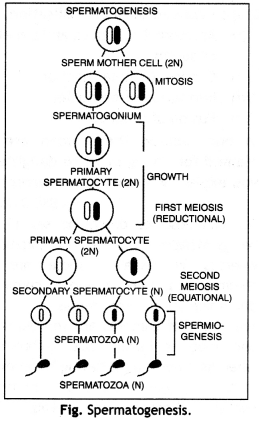
Question 28.
What role do pituitary gonadotropins play during the follicular and ovulatory phases of the menstrual cycle? Explain the shifts in steroidal secretions.
Answer:
Gonadotropin-releasing hormone (GnRH) also called gonadotropin-releasing factor (GnRH) is secreted by the hypothalamus of the brain, which stimulates the release of follicle-stimulating hormone (FSH) and luteinizing hormone (LH). FSH stimulates the ovarian follicles to produce estrogens during the proliferative phase. LH stimulates the corpus luteum of the ovary to secrete progesterone.
- The menstrual phase is caused by the reduction of progesterone and estrogens.
- The proliferative phase is caused by the increased production of estrogens.
- LH causes ovulation. LH also causes a transformation of the empty Graafian follicle into the corpus luteum by luteinization inside the ovary. LH also stimulates the corpus luteum to secrete progesterone hormone to help in implantation, placentation, and maintenance of pregnancy.
- A secretory phase is caused by the increased production of progesterone.
Question 29.
A woman has conceived and implantation has occurred. Discuss the sequence of changes up to parturition which will take place within her body under the influence of hormones.
Answer:
- Under the impact of progesterone and estrogen the size of the uterus and birth canal increases. Relaxation of pelvic ligament takes place. The placenta is developed between chorionic and uterine tissues.
- Breast size increases to full maturity under the impact of progesterone. Corpus luteum grows in the early month and then regresses in the later month.
- Menstrual cycle and ovulation do not occur.
- Uterine changes: Sex hormones, the estrogenic and placental gonadotropins are excreted with urine.
- The volume of blood increases.
Some of the endocrine glands such as the adrenal cortex, anterior pituitary, and thyroid show enlargement. Relaxin hormone is essential in relaxing the pelvic ligament during parturition.
Oxytocin controls uterine contraction during childbirth.
Question 30.
The zygote passes through several developmental stages till implantation. Describe each stage briefly with suitable diagrams. (CBSE 2010)
Answer:
Cleavage is a holoblastic type but there is a tendency to show size differences of the blastomeres from the very start. Cleavage

Fig. CLeavage in mammalian ovum (pig) Fri sectional view A. zygote; B. two-ceU stage; C. four-cell stage: D. sixteen-celL stage; E. morula stage; F and G. Blastocyst (diagrammatic)
The first cleavage takes place in the cytoplasm of the ovum on an imaginary axis (animal pole to vegetal pole). The first division results in two blastomeres. One blastomere is slightly larger than the other. The larger cell divides first and thus forms the three blastomeres. Then the smaller blastomere divides and thus four blastomeres are formed. It is a 4-celled stage.
2nd cleavage is at a right angle to the 1st cleavage. One member of the large blastomeres of 4-cell stage divides forming 5-cell condition followed by 6-7 stage ultimately 8-celled stage. Successive cleavage divisions result in the formation of the solid mass of cells. The thus solid ball-like stage is called the morula stage.
Conversion of morula into blastula is initiated by dynamic rearrangement of small blastomeres. A central fluid-filled cavity called blastocoel (segmentation cavity) appears. Externally placed blastomeres lose their rounded form and become flat. This trophoblast along with the lining of the uterus forms extra-embryonic membranes. This provides protection and nourishment to the developing embryo.
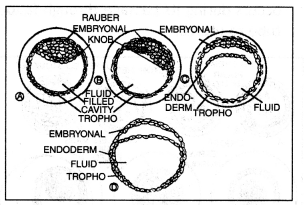
Fig. Development of a blastodermic vesicle (blastocyst) in pig (diagrammatic sectional view).
Simultaneously zona pellucida disappears and the embryo gets implanted into the uterus. Below the blastodermic vesicle, there appears formative tissue, i.e. inner cell mass. From this inner cell mass, the proper embryo is formed.
Question 31.
Explain the following:
(i) Failure of testes to descend into the scrotum produces sterility.
Answer:
Failure of testes to descend into scrotum is called cryptorchidism. It leads to sterility because the scrotum provides a lower temperature (2°C) than the body temperature necessary for the spermatogenic tissue of testes to produce sperms.
(ii) Spermatids possess a haploid chromosome number.
Answer:
Spermatids possess haploid chromosome numbers because they are produced as a result of spermatogenesis (a kind of reductional or meiotic division). Moreover, it is essential because during fertilization diploid number of chromosomes will be restored in the fertilized egg. The haploid number of chromosomes in the spermatids helps in the maintenance of a specific number of chromosomes in the species.
(iii) The first half of the menstrual cycle is called the proliferative phase as well as the follicular phase.
Answer:
The first half of the menstrual cycle is called the follicular phase because estrogens secreted by the cells of maturing Graafian follicles control the changes in the secondary sex organs. It is also called the proliferative phase because the growth and proliferation of tissue on the wall of the uterus, vagina take place.
(iv) The second half of the menstrual cycle is called the luteal phase as well as the secretory phase.
Answer:
The second half of the menstrual cycle is called the secretory phase as well as a luteal phase because during this phase secretion occurs due to the luteinizing hormone (LH) which stimulates ovulation, the formation of corpus luteum and progesterone.
(v) Primary sex organs control the growth, function, and maintenance of secondary sex organs.
Answer:
Primary sex organs control the growth, function, and maintenance of secondary sex organs because they secrete hormones such as testosterone in males and estrogen and progesterone in females.
(vi) Why are the human testes located outside the abdominal cavity? Name the pouch in which they are present. (CBSE 2014)
Answer:
(a) Testes are located in the scrotal sac (scrotum).
(b) It helps in maintaining the low temperature (2-2.5°C) lower than the normal body temperature required for maturation of sperms.
Question 32.
Describe the formation of three germ layers in a mammalian embryo.
Answer:
The blastodermic vesicle is surrounded by the outer cellular layer (trophectoderm). The blastodermic vesicle shows an internal cluster of cells due to differentiation. This cluster of cells is called inner cell mass. Now the morphogenetic movements (epiboly, emboly, etc.) of the cells in small masses or sheets take place. As a result, three germinal layers (i.e. endoderm, mesoderm, and ectoderm) are formed. Formation of endoderm.
Some cells from the inner cell mass detach. Cells move in sheets or masses in the blastocoel. These are the potential endodermal cells. These cells arrange themselves as second layer inner to the outer layer of a blastodermic vesicle. The blastocoel disappears and a new cavity appears. This new cavity is called archenteron or primitive gut. This archenteron will give rise to the gut tract.
Formation of mesoderm: At the margin of the embryonic disc, cells multiply at an increased rate. The thickness of the embryonic disc increases. These cells detach from the embryonic disc and give rise to the mesoderm.
Formation of ectoderm: After the formation of mesoderm, the cells of the embryonic disc arrange themselves so as to form the ectoderm.
Question 33.
Write functions of the placenta.
Answer:
The placenta serves primarily as an organ that permits the interchange of materials carried in the blood of mother and fetus. Its main functions are:
- Nutrition: Supply of nutrient materials to the fetus.
- Respiration: Supply of 02 to the fetus and receives C02 back from it.
- Excretion: Fluid nitrogenous waste products escape through the placenta.
- Barrier: The placenta is a barrier-like semipermeable membrane.
- Storage: The placenta stores fat, glycogen, and iron for the embryo before the formation of the liver.
- Hormonal function: The placenta secretes extra ovarian hormones estrogen and progesterone in females during pregnancy that serves to maintain the fetus.
Question 34.
Briefly describe the process of oogenesis. (CBSE 2004)
Or
Give a schematic representation of oogenesis in humans. Mention the number of chromosomes at each stage. Correlate the life phases of the individual with the stages of the process. (CBSE (Delhi) 2008, 2009 (S), Outside Delhi 2013)
Or
When and where are primary oocytes formed in a human female? Trace the development of these oocytes till ovulation (in the menstrual cycle). How do gonadotropins influence this developmental process? (CBSE 2010)
Answer:
Oogenesis:
1. The phenomenon of the formation of haploid ova (egg) from the diploid egg mother cell of Ovary (female gonad) is called oogenesis. It occurs in three phases, i.e. multiplication, growth, and maturation.
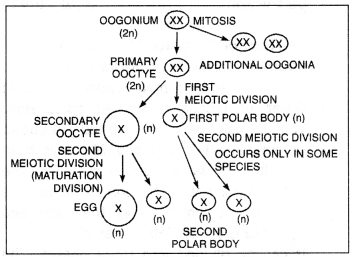
Fig. Oogenesis
2. One ovum (n) is formed from one primary oocyte (2n) as a result of oogenesis.
3. The oogenesis is also controlled by the FSH hormone.
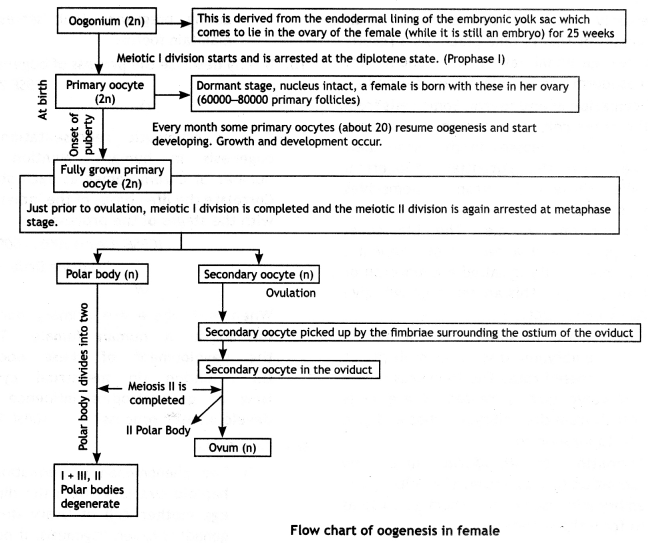
Question 35.
How does parturition take place? Which hormones are involved in the induction of parturition? (CBSE 2019 C)
Or
‘Parturition is induced by a complex neuroendocrine mechanism’. Justify. (CBSE Sample Paper 2018-2019)
Answer:
The onset of labor is termed parturition. The human gestation period (duration of pregnancy) is normally 280 days from the time of the last menstrual period to the birth of the baby. The process of uterine contractions that expel the baby and placenta is called ‘labor pains’.
It can be divided into three phases. The first stage is dilation, which usually lasts from 2 to 20 hours and ends up with the cervix of the uterus fully open or dilated. The second state, expulsion which lasts from about 2 to 100 minutes begins with full crowning, the appearance of the baby’s head in the cervix and continues while the baby is pushed, head first, down through the vagina into outside where it draws its first breath.
During this phase, placentation which lasts for 10-15 minutes after the birth of the child, the placenta and the fetal membranes are loosened from the lining of the uterus by another series of contractions and expelled. They are collectively called after birth or decidua.
Hormonal control:
- Oxytocin (birth hormone) promotes the contraction of the uterine muscles.
- Relaxin allows the pubic symphysis and ligaments to dilate.
- Corticotropin-releasing hormone (CRH) takes part in the ‘Clock’ that establishes the timing of birth.
Question 36.
A mother is ready to feed her newborn baby just after parturition by nature.
(i) Name the cells which secrete milk.
Answer:
Lacteriferous cells of alveoli of mammary glands. They are present in the breast.
(ii) Name the process of producing the milk.
Answer:
Lactation.
(iii) Name the milk produced during the first few days, after parturition.
Answer:
Colostrum.
(iv) Name the hormone meant for the release of milk.
Answer:
Oxytocin hormone released by the posterior lobe of the pituitary body.
(v) Why the doctors recommend breastfeeding during the initial period of infant growth? (CBSE Delhi 2016)
Answer:
Mother’s milk is low in fat but rich in proteins such as lactalbumin and lactoprotein. Colostrum also contains major immunoglobin IgA. It provides passive immunity to the newborn baby.
Question 37.
Describe the structure of an ovum.
Or
1. Draw a diagram of the structure of a human ovum surrounded by corona Radiata. Label the following parts:
(a) Ovum
(b) Plasma Membrane
(c) Zona Pellucida.
2. State the function of Zona Pellucida. (CBSE Delhi 2013)
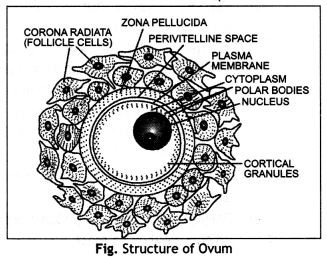
Answer:
1. Structure of ovum: Most animaL eggs are spherical or oval, non-motiLe but on close examination, it is noted that one pole is different from the other. The pole from which polar bodies are given off is called an animal pole while the opposite is termed as a vegetal pole. Thus it is said to have polarity. Thus various cytoplasmic substances are distributed along the axis in an unequal manner.
The nucleus also called (germinal vesicle) having a chromatin network is surrounded by the nuclear membrane. It also contains prominent nucleolus. All animal eggs contain some reserve material to provide food called yolk. The cytoplasm of an ovum is called the ooplasm. It lacks a centrosome but contains cortical granules derived from Golgi bodies in its outer region termed cortex.
2. Function of Zona pellucida: During fertilization as a result of the cortical reaction, zona pellucida hardens and prevents the entry of additional sperms (polyspermy).
Question 38.
(i) Explain the following phases in the menstrual cycle of a human female:
(a) Menstrual phase
(b) Follicular phase
(c) Luteal phase
Answer:
Menstrual cycle: The cyclic changes that occur in the reproductive organs of primate femaLes (monkeys, apes, and human beings) constitute the menstruaL cycLe. The cycLe of events starts from one menstruation tiLt the onset of the next and Lasts for about 28/29 days (a menses).
Simplified menstrual cycle (28-day Cycle):
| Phase | Days | Events |
| Menstrual phase | 1-5 | Endometrium breaks down, menstruation begins. The cells of en domain urn, secretions, blood, and the unfertilized ovum constitute the menstrual flow. |
| Follicular phase (ProLiferative phase) | 6-13 | Progesterone production is reduced. In fact, menstrual flow is associated with withdrawaL of progesterone. |
| Ovulatory phase | 14 | Endometrium rebuilds, FSH secretion, and estrogen secretion increase. |
| Luteal phase (Secretory phase) | 15-28 | Both LH and FSH attain a peak level. The concentration of estrogen in the blood is also high and reaches its peak. Ovulation occurs. Corpus luteum secretes progesterone. The endometrium thickens and uterine glands become secretory. |
(ii) A proper understanding of the menstrual cycle can help immensely in family planning. Do you agree with the statement? Provide reasons for your answer. (CBSE Delhi 2017)
Answer:
Yes, a proper understanding of the menstrual cycle can help immensely in family planning. Day 10 to 17 of the menstrual cycle is called the fertile period of a human female. If coitus is done during this period, there is an increased chance of conception. But if coitus abstains during this period, pregnancy can be prevented. Pills used by females are also dependent on the menstrual cycle.
The pills have to be taken daily for a period of 21 days starting preferably within the first five days of the menstrual cycle. It is repeated again after a period of 7 days. These inhibit ovulation and implantation as well.
Question 39.
(i) Explain the menstrual cycle in human females.
Answer:
Menstrual cycle: The cycLic changes that occur in the reproductive organs of primate femaLes (monkeys, apes, and human beings) constitute the menstruaL cycLe. The cycLe of events starts from one menstruation tiLt the onset of the next and Lasts for about 28/29 days (a menses).
(ii) How can the scientific understanding of the menstrual cycle of human females help as a contraceptive measure? (CBSE Delhi 2018)
Answer:
Scientific understanding of the menstrual cycle can be helpful in human females to adopt any contraceptive measure as it can help in demarking the dates during which the chances of contraception are higher. For example, periodical abstinence is one such method in which couples avoid coitus during the 10-17 day of the menstrual cycle when ovulation is expected. Coitus can also be avoided during the time span in which the chances of fertilization are higher if there is a scientific understanding of the menstrual cycle.
Question 40.
(i) Draw a diagram of the adult human female reproductive system and label the different:
(a) parts of the fallopian tube
(b) layers of the uterus wall
Answer:
The female reproductive system of human:

(ii) Explain the events during the fertilization of an ovum in humans. (CBSE Delhi 2018C)
Answer:
When sperm comes in contact with zona pellucida of the ovum, this induces changes in the membrane that blocks the entry of additional sperm.
Thus, it ensures that only one sperm can fertilize an ovum. Secretion of acrosome helps sperm enter into the cytoplasm of the ovum through zona pellucida and plasma membrane. This induces completion of the meiotic division of secondary oocyte and the formation of a haploid ovum and a second polar body. The haploid nucleus of the ovum fuses with the sperm nucleus to form a diploid zygote, i.e. fertilization occurs.
Question 41.
(a) Name the hormones secreted and write their functions:
(i) by corpus luteum and placenta (any two).
Answer:
The Corpus luteum and placenta secrete progesterone. It helps in maintaining the pregnancy as a rising level of progesterone inhibits the release of GnRH which in turn inhibits the production of FSH, LH, and progesterone.
(ii) during the Follicular phase and parturition.
Answer:
FSH is secreted during the follicular phase. It stimulates the growth of the ovarian follicles and also stimulates the formation of estrogen. Relaxin is secreted during parturition. It softens the connective tissue of public symphysis that facilitates parturition.
(b) Name the stages in a human female where:
(i) Corpus luteum and placenta co-exist.
Answer:
The Corpus luteum and placenta co-exist up to blastocyst formation.
(ii) Corpus luteum temporarily ceases to exist. (CBSE (Delhi) 2017)
Answer:
During the menstruation phase corpus luteum ceases to exist.
Very Important Figures:
